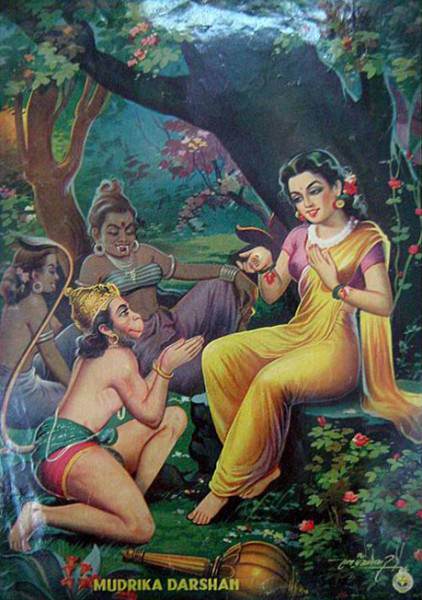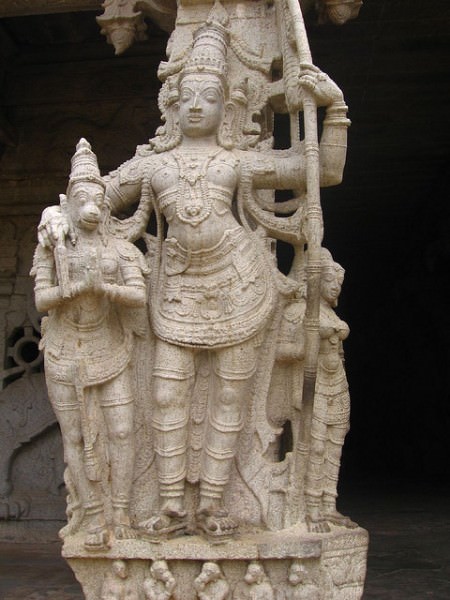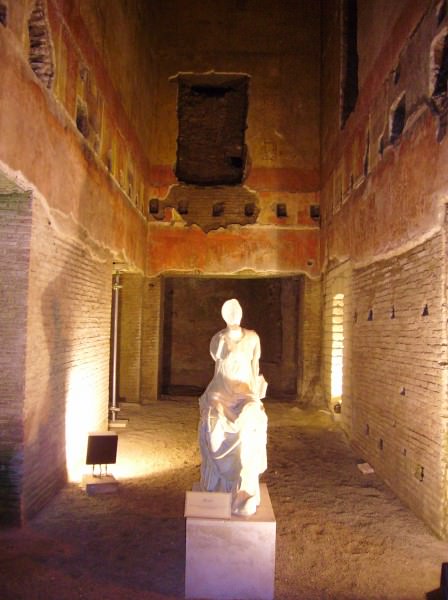Hanuman › Nero's Golden House » Origins and History
Articles and Definitions › Contents
- Hanuman › Antique Origins
- Nero's Golden House › Ancient History
Ancient civilizations › Historical places, and their characters
Hanuman › Antique Origins
Definition and Origins

Hanuman is one of several zoomorphic characters in Indian mythology, but is the only wholly animal figure who is revered as a god today. The mythic texts speak of him as a monkey child of the Wind God, as possessing enormous strength, keen intellect and a mastery over the Vedas and other branches of learning. He is also an unquestioning devotee of Rama, the hero of the epic Ramayana, and has the ability to take on any form he wishes.
HANUMAN IN THE RAMAYANA
The first reference to Hanuman in the epic Ramayana is casual - as a "group of monkeys" - and one has no inkling of the large role that he will go on to play in the remainder of the story. Ravana, a demon, abducted Sita, wife of the exiled prince Rama.When Ravana was carrying away Sita in his air-borne chariot, Sita saw some monkeys atop a mountain and threw down her ornaments, hoping that monkeys with ornaments would attract the attention of her husband Rama, who would surely be searching for her in the same forest. Hanuman was one of these four monkeys. This monkey group was instrumental in giving Rama key information about Sita. They helped him build a bridge across the seas, and cross over with a monkey army that successfully stormed the demon stronghold and freed Sita.
Hanuman's role in the battle between Rama and Ravana is huge. He is the one who flies across the oceans (he is Wind's child), locates the exact place where Sita is imprisoned and brings this information back to Rama. While within the demon fort on his quest for Sita, he sets the entire place on fire and warns Ravana about an impending attack unless Sita is returned unharmed.
FROM HIS FATHER, THE WIND GOD, HANUMAN INHERITS HIS MIGHT & SPEED. HE IS ALSO A SHAPESHIFTER WHO CAN INCREASE & DECREASE HIS BODY SIZE AT WILL.
During the Rama-Ravana battle, Hanuman not only kills several demon generals but also brings Rama's brother back to life.How does he do that? Well, it so happens that Rama's brother is mortally wounded by Ravana's son, and the monkey-army-physician opines that the only things that can save the life of the younger prince are four specific herbs that grow on the Himalayan slopes. The catch? The battle is raging on in Lanka, across the southernmost tip of the country while the Himalayas are far up north, and the herbs are needed within the next few hours, before the new day dawns. Hanuman leaps up into the air, flies northwards at lightning speed, and alights atop the Himalayas. This is where things start to become confusing: the monkey-physician had said that medicine herbs glow in their own light and that it should be easy, therefore, to spot them. What Hanuman sees, however, is an entire mountain aglow with herbs of all kinds, each emitting its own peculiar light. Being unable to identify the exact four herbs that the physician had described, Hanuman uproots the entire mountain and carries it back to the battlefield. The physician gets his herbs, the near-dead prince is brought back his life, and, so strong is the effect of the mountain teeming with a thousand fragrant herbs that other monkeys who had fallen in battle are also healed just by inhaling the medicine-scented mountain air.

Hanuman finds Sita
Hanuman is described in the epic as one of extremely pleasant visage, perfect diction, elegant speech, and faultless manners.He is also described as being knowledgeable in the three Vedas. From his father, the Wind God, he inherits his might and speed. He is also a shapeshifter who can increase and decrease his body size at will.
HANUMAN IN THE MAHABHARAT
The Mahabharat is an epic about two branches of a family warring for a throne. One of the princes in the Mahabharat is also a son of the Wind God and it is to him that Hanuman's makes his only appearance in this epic. This prince, named Bhima, was as mighty as the wind and had once wandered into a large banana grove, which he proceeded to randomly destroy. While tearing down fruit and uprooting trees, he saw an old monkey dozing by the wayside, its tail lying right across the grove path.Bhima ordered the monkey to move its tail aside; the monkey opened his eyes and said it was rather weak and if the prince could be kind enough to lift it gently aside he would be grateful. Bhima, not given to either patience or conversations with lesser beings, bent to pick the monkey up by its tail, intending to hurl it across the banana trees. However, to his surprise, try as he might, he could not move even a whisker of the tail. It transpired that the monkey was none other than Hanuman, the mightiest being on earth. "Strength should not be trifled with; neither should it be something to be vain of", or words to similar effect, were what Hanuman told the chastened Bhima.
As a mark of affection to Bhima, Hanuman agreed to reside on the flag of Bhima's younger brother Arjuna 's chariot. It is for this reason that Arjuna is called Kapi-dhwaj ( kapi = monkey, dhwaj = flag, kapi+dhwaj = ape-bannered). During the final terrible Mahabharat war, Arjun's war cries were amplified by the roar that would emanate from the ape emblem on his flagstaff, driving fear into the hearts of his enemies.

Rama & Hanuman
HANUMAN IN THE PURANAS
Hanuman is the child of the Wind God and the princess Anjana. He is referred to by his metronymic, Anjaneya, as often as his patronymic, which seems to be the norm in most of the Hindu mythological texts. The various Puranas say that Anjana was married to the monkey chief Kesari. The couple prayed to Shiva for a son, and Hanuman was born to them from an aspect of Shiva, through the agency of the Wind God. Thus, Hanuman has two patronyms: Vayu-putra (Wind's son) as well as Kesari-nandan (Kesari's son).
So why is he called Hanuman then? The story is this: as soon as he was born, Hanuman grew up to a considerable size, jumped about like all monkeys do, and asked his mother what he should eat. Anjana pointed to the rising sun, a sphere of red in the golden dawn, and told him that anything that looked like that (ie ripe fruits) was his food. Hanuman mistook the sun itself to be a ripe fruit and leapt up in the air to grab it. The king of gods, seeing a dark streak speeding across the sky towards the sun as if to swallow it whole, was alarmed and hurled his thunderbolt at the flying figure. Whereupon Hanuman roared with laughter and said, "Do you not know, King, that I am unslayable? I am born of Shiva, how can your thunderbolt do anything to me? However, just so the Worlds do not laugh at you, I allow your weapon to scratch my chin". Or, words to that effect. Thus, the honour of the king of gods was retained, the infallible thunderbolt hit its target, the monkey child got his chin disfigured, and came to be known as Hanuman ( hanu = chin; man = of, with, bearing, having; hanu+man =he of [broken] chin).
The Puranas also tell us that Hanuman was taught the Vedas and all other branches of learning by Sun God himself, Surya.He learnt his lessons by trotting alongside the Sun's chariot as it moved across the sky.

Hanuman
HANUMAN IN LATER LITERATURE
During the 16th CE, a poet called Tulsidas retold the Ramayana in the vernacular Awadhi language (rather than the academic Sanskrit ) and also composed several hymns to the gods. One such hymn, the Hanuman Chalisa, continues to be recited today by thousands of people. This canticle of about 40 verses celebrates all of the qualities that Hanuman came to signify over the centuries: strength, devotion, celibacy, and righteousness. Hanuman became a god. In an extract from the Hanuman Chalisa,
भूत पिशाच निकट नहिं आवै।
महाबीर जब नाम सुनावै॥
नासै रोग हरै सब पीरा।
जपत निरंतर हनुमत बीरा॥Demons and ghosts do not come near
If they hear the mighty one's name
Diseases die, sorrows disappear
If one constantly chants Hanuman's name
HANUMAN IN THE 21ST CENTURY
Hanuman is worshipped as a god in several parts of India today. It is almost de rigueur to find a small shrine to him in police stations and wrestling clubs across the country, especially in the north. Outside of India, Hanuman is known in countries which were influenced by the Hindu culture such as Indonesia, Thailand, and Malaysia.
Hanuman is a recurring figure in the panels and motifs of the Ramayana that adorn the temples that were built over the centuries in India. He is most often depicted with his favourite weapon, the mace. He is also often depicted as flying across the skies, one hand holding aloft the mountain of herbs and the other a mace.
Nero's Golden House › Ancient History
Ancient Civilizations
Nero 's Golden House (the Domus Aurea) in Rome was a sumptuous palace complex which played host to the wild parties of one of Rome's most notorious emperors. Besides using the finest marble and decoration such as fine wall -painting and gilded colonnades, the building was also a technical marvel with soaring domes, revolving ceilings, ornamental fountains and even waterfalls running down the walls.
Following the devastating fire of 64 CE which had destroyed large areas of the Aventine and Palatine hills, Nero decided to take the opportunity to build a huge new palace. To have enough space for the project the emperor - already unpopular due to accusations of a slow response to the fire and even possibly having started it - seized large areas of land owned by aristocrats and even carved into the Oppian hillside in the building's rear. For the construction of the palace Nero turned to the architect Severus and the engineer Celer, already celebrated as masters of grand architecture, whilst for the interior decoration and wall-painting he turned to Famulus whose work would be studied centuries later by Renaissance artists. When the whole magnificent project was finally finished Nero declared with satisfaction: 'Now I can begin to live like a human being'.

Domus Aurea
The best preserved part of the complex is the west wing which hints at the sumptuous nature of this one-time pleasure palace.There were two floors which boasted at least 140 rooms with ceilings up to 11 metres high. The principal entrance was along the via Sacra coming from the Forum. The main gateway also included a massive 30 metre high gilt-bronze statue of Nero as the sun god and the palace was surrounded by vast landscape gardens covering 125 acres which were further expanded by parklands and a lake.
SUETONIUS DESCRIBES GEM-ENCRUSTED WALLS, IVORY AND MOTHER-OF-PEARL DECORATIONS, & CEILINGS WHICH SHOWERED GUESTS WITH FLOWERS AND PERFUMES.
Large areas of the ground floor were dedicated solely to banquet rooms laid out in a bewildering maze of rooms in all shapes and sizes and all decorated with sumptuous wall-paintings. The west wing, for example, had one rectangular courtyard surrounded by no fewer than 50 banquet rooms. There was a large pentagonal courtyard brightly decorated with glass mosaicwhich branched off into 15 separate rooms. One of these was the 'room of the Golden Vault' with its gilded ceiling, marble panelling and grand picture from Greek mythology of Zeus abducting Ganymede. There was a large octagonal room with a concrete dome, probably originally covered in glass mosaic. This dome and, in general, the use of concrete for vaulting in the building were innovations which would become common features of later Roman architecture. Suetonius also offers a famous description of one of the domed ceilings or perhaps even the room itself: '[there was a] circular banquet hall, which revolved incessantly, day and night, like the heavens'. Such devices are mentioned elsewhere in both earlier and later Romanbuildings and excavations have revealed evidence that water may have powered this wonderful entertainment for Nero's guests. Suetonius also describes gem-encrusted walls, ivory and mother-of-pearl decorations, and ceilings which showered guests with flowers and perfumes.

Bust of Nero
The octagonal hall led to rooms on five sides, each of which had a waterfall running down their back wall. Nearby was the 'room of Achilles on Skyros' with marble and painted stucco walls. Yet another large hall had a 13 metre high vaulted ceiling made out to look like a cave by covering it with pumice stone. It also carried a mosaic depicting the Cyclops Polyphemus. The subterranean effect was further enhanced with the addition of fountains which ran down the walls, the water collecting in large pools in the surrounding rooms. All of these wonderful features and their accompanying array of sun-courts, sitting rooms, access corridors and service rooms were probably repeated, or at least matched, in the East wing, the two being joined by a huge colonnade, possibly with two levels.
The upper story is much more difficult to reconstruct due to the lack of surviving evidence. A small part of the upper story of the octagonal court survives which has a light-well to provide light to the floor below, two small courtyards with fountains, and a colonnade running along one side of a large ornamental pool.
Following Nero's death, and with his successors wishing to distance themselves from this unpopular emperor, the building was abandoned and stripped of much of its precious marble for reuse elsewhere. Most of the structure has disappeared under the foundations of later buildings such as the Baths of Trajan or lies buried. So too, the gardens were built over and the great lake was drained and the Colosseum built on top. In Medieval times the site became overgrown and was used to grow vegetables and vines, a tranquil contrast for what was once the site of Imperial Rome's most raucous and debauched partying.
LICENSE:
Article based on information obtained from these sources:with permission from the Website Ancient History Encyclopedia
Content is available under License Creative Commons: Attribution-NonCommercial-ShareAlike 3.0 Unported. CC-BY-NC-SA License